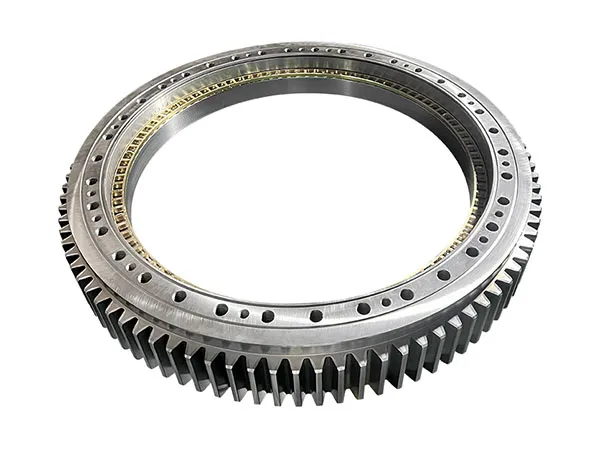Slewing bearings withstand radial loads through a combination of their internal geometry, the distribution of force across multiple rolling elements, and the structural rigidity of their rings.
How Slewing Bearings Withstand Radial Loads

1. The Foundation: What is a Radial Load?
First, let’s be clear on the force we’re talking about. In the context of a slewing bearing (like the one on a crane), a radial load is a force that pushes or pulls on the bearing from the side, perpendicular to the central axis of rotation.
Example: The force of the wind pushing against the side of a long crane boom.
Contrast with other loads:
Axial (or Thrust) Load: A force acting parallel to the axis of rotation (e.g., the weight of the crane’s cabin and boom pushing straight down).
Moment (or Tilting) Load: A force that tries to tip or overturn the bearing (e.g., the weight of a heavy object lifted at the end of the crane boom).
Slewing bearings are remarkable because they are designed to handle all three types of loads simultaneously. Their ability to handle radial loads is a direct result of this multi-load design.
2. The Core Mechanism: Raceway Geometry and Contact Angle
The “magic” happens inside the bearing, specifically in the way the rolling elements (balls or rollers) make contact with the inner and outer rings (the raceways).
A. For Four-Point Contact Ball Bearings (The Most Common Type)
This is the classic design. Imagine cutting a slewing bearing in half. You would see that the groove (raceway) the balls run in is not a simple semi-circle. It’s shaped like a gothic arch or two shallow V’s.
How it Works: When a radial load pushes the inner ring sideways, the balls are forced up the angled raceways of both the inner and outer rings.
The Contact Angle: The force is transmitted through the balls at an angle (the “contact angle”). This angle means that a single radial force is resolved into two components: one that is axial and one that is radial.
The Key Takeaway: Because the ball contacts the raceway on an angle, it can resist forces from both the side (radial) and top/bottom (axial) simultaneously. A single ball acts like two separate bearings pushed against each other at an angle, all in one compact design.
B. For Crossed Roller Bearings
This design is even more explicit in how it handles loads from different directions.
How it Works: Cylindrical rollers are arranged in a crisscross pattern, with each roller oriented at 90 degrees to the one next to it.
…
For more detailed information on how slewing bearings can withstand radial loads, click to visit:https://www.mcslewingbearings.com/a/news/how-slewing-bearings-withstand-radial-loads.html



